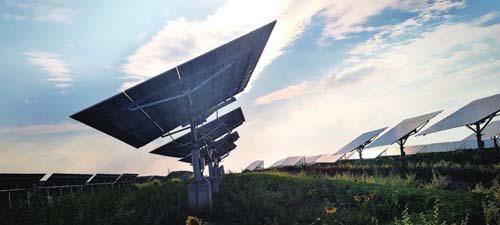Top Runners
2018-09-19ByZhangShasha
By Zhang Shasha

Strolling along lanes lined with lush vegetation, decorated sporadically with clusters of sunflowers, it is hard to imagine that the surrounding land where a new energy power base stands was once ravaged by mining, left pockmarked and barren by the long-term and high-intensive extraction of coal.
Datong, a city in north Chinas Shanxi Province, is regarded as the countrys coal capital and has long been a crucial source of energy. However, the exploitation of the regions natural resources has led to a 1,687-square-km area of subsidence, or unstable ground. As a result, thousands of houses have collapsed and farmland in some areas was so damaged that residents were left with no choice but to move.
“Coal-mining subsidence is present in around 12 percent of Datongs total area,”said Ma Anquan, the citys deputy mayor, adding that ecological restoration is a tough challenge.
In order to tackle the issue, the govern- ment proposed the development of the photovoltaic (PV) industry in the area and growing plants beneath the PV modules so as to rejuvenate the land. The move is conducive to transforming Datongs coaldominated energy structure, encouraging the citys transition following the exhaustion of its resources and, more importantly, upgrading Chinas PV industry itself.
Mining subsidence
Given that the regions unstable structure has resulted in hidden peril for peoples safety, the local government began relocating residents in 2004. According to the Datong authorities, by the end of 2017, some 74,000 residents had been removed from dangerous zones, setting aside vast stretches of land suitable for the construction of PV power stations.
“PV modules are not allowed to occupy arable land, so the land that had been damaged was a good choice,” said Liu Chengkui, chief representative of the Taiyuan Representative Office of the China Power International Holding Limited, a subsidiary of the State Power Investment Corporation(SPIC), which is one of the companies that constructed the Datong PV demonstration base.
He said enterprises that wish to use the land can rent it for 400 yuan ($58) per mu(0.07 hectare) from residents. “It is good news for local people because they are now earning stable rents,” Liu said.
In addition, beneath the PV modules lay various plants and trees such as Sabina vulgaris, sunfl owers and even roses. Liu said that in drought areas like Datong, plants that are protected by modules are more likely to retain moisture than those exposed to the sun. Now, a total of 628 acres of subsidence occupied by SPICs power station have been incased in a tint of green.
According to Meteonorm, a database of 8,325 meteorological stations and five geostationary satellites, the annual solar irradiation of Datong is more than 1,400 kWh per square meter. It ranks second among cities in Shanxi and belongs to the secondtier region in terms of solar energy. Thus, cultivating the PV industry is an opportunity for Datong to surmount the downward economic pressure caused by its exhausted coal resources.
The PV industry has brought social, environmental and economic benefits to the land, which has now been converted from an abandoned wasteland to a treasure trove, a place now hailed by the National Energy Administration (NEA) as one of the demonstration bases of new PV technologies.
The program
Datongs transformation can be traced back to June 25, 2015, when its coal-mining subsidence area became the fi rst demonstration base with advanced PV technologies to be approved by the NEA as part of the Top Runner program.
According to the NEA, the program aims to apply the technology and experience harvested from demonstration bases such as the one in Datong to other PV projects so as to promote cutting-edge technologies, lower cost, reduce corporate reliance on government subsidies and promote high-quality development.
“We have chosen five types of racks—both fixed and adjustable—and by designing the arrays according to solar conditions and geomorphic features, we are exploring an optimized plan to maximize efficiency,” said Liu. Moreover, practical data from each type will be recorded to see which achieves better results, benefi ting the entire industry.
Strict assessment criteria was established to select candidates for construction in the area as the conversion effi ciency of the solar cells used in the Top Runner program is 1 percent higher than ordinary PV programs, according to Datongs development and reform commission.
“The conversion efficiency of the single crystalline silicon solar cells that we used in our project is 17.12 percent, which was the most advanced in 2015,” said Liu.
According to the China Photovoltaic Industry Association, the Top Runner technical indicators developed from 16.5-17 percent in 2015 to 17-17.8 percent in 2017, indicating that the market is demanding more technological innovation and provoking more competition in the fi eld.
The SPICs 100-megawatt Chenguang PV power plant was the first among the 13 selected projects to connect to the grid under the fi rst phase of the Datong Top Runner program, and the highest ranking in terms of technical criteria.
With these advantages, the SPIC won the bids for a total of 400 megawatts of projects for the second phase of the program which began construction on June 29 and is expected to fi nish before November 30, accounting for 80 percent of the total capacity quota of the second phase.
The first two phases of the Top Runner program have made many significant achievements. Technology, a top priority for PV manufacturers involved in the program, has been improving—some advanced technological fruits have been generalized in the PV industry; the conversion effi ciency of solar cells required in the program in 2015 has become a common standard for the whole industry.
Due to competition among companies, the average feed-in tariff was 0.2 yuan ($0.03) lower than the benchmark price per kilowatt hour set by the government, declining more than 20 percent. The move has not only encouraged enterprises to improve their competitiveness, but also helped to reduce government subsidies.
Quality over quantity
On June 1, 2018, the Chinese Government issued new rules for PV installations, stating that no construction plans will be advanced for common PV projects this year and the national feedin tariff will be cut by 0.05 yuan ($0.0073) for every kilowatt hour. The new rules shocked the PV industry since companies without core competitiveness will suffer under the new policy.
Chinas PV industry has ranked first in the world for the past fi ve years in regards to newly installed capacity attributed to government subsidies, but in some localities, PV capacity is not in full use and has even been abandoned.
The new rules aim to regulate excessive capacity and seek high-quality development, which happen to coincide with the goals of the Top Runner program. The Chinese Government tries to steer the PV industry from high speed growth to high quality, aiming to direct it onto a more rational development path.
In response to the new policy, PV corporations are exploring new ways to gain core competitiveness and survive under the tide of reform.
Liu concluded that “improving PV technology and reducing costs are both crucial for PV corporations and for weaning them off government subsidies.”
“Due to technology development, the price of PV modules has been slashed from 4 yuan ($0.58) to 2 yuan ($0.29),” Liu told Beijing Review, adding that the feed-in tariff of the Top Runner program has been lowered from 0.95 yuan ($0.14) per kilowatt to 0.39 yuan ($0.057) per kilowatt hour since 2015.
“Now, the PV industry needs to attach more importance to improving quality and efficiency and promoting technological development rather than scaling up further,”said Li Chuangjun, deputy head of the New Energy and Renewable Energy Department of the NEA. “This should be the basic ethos for the development of the PV industry in the years to come.”
